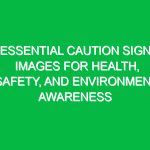Personal Protective Equipment (PPE) is a crucial component in the Health, Safety, and Environment (HSE) domain, ensuring the protection of individuals from various workplace Hazards. A comprehensive PPE equipment list is essential for organizations committed to maintaining a safe work environment. This article explores the significance of PPE, details a thorough equipment list, discusses compliance with Regulations, and offers actionable insights for successful implementation in HSE practices.
Understanding the Importance of PPE in HSE
PPE encompasses a variety of protective gear designed to minimize exposure to Hazards that can cause serious injuries or illnesses. In industries such as construction, healthcare, and manufacturing, the potential risks are significant, making the correct use of PPE indispensable. For instance, a construction worker without a hard hat is at a much higher risk of head injury from falling debris, while a healthcare worker without gloves may be exposed to infectious diseases. Therefore, having a well-defined PPE equipment list not only safeguards employees but also fosters a culture of Safety within the organization.
Comprehensive PPE Equipment List
To ensure Workplace Safety, organizations should tailor their PPE equipment list to address specific hazards. Below is a detailed list of essential PPE items categorized by their specific use:
1. Head Protection
- Hard Hats: Protect against impact from falling objects and electrical shocks.
- Bump Caps: Suitable for low-risk environments to protect against minor bumps.
2. Eye and Face Protection
- Safety Glasses: Shield eyes from flying debris and chemical splashes.
- Face Shields: Provide full-face protection in environments with hazardous materials.
- Goggles: Offer a tight seal around the eyes for chemical protection.
3. Hearing Protection
- Earplugs: Reduce noise exposure in loud environments.
- earmuffs: Provide additional protection against higher noise levels.
4. Respiratory Protection
- Dust Masks: Suitable for protection against non-toxic dust.
- Respirators: Necessary for environments exposed to hazardous fumes and airborne particles.
5. Hand Protection
- Gloves: Different types for chemical, cut, heat, and impact resistance.
- Cut-resistant gloves: Essential for industries with sharp tools or materials.
6. Body Protection
- Coveralls: Protect against chemicals and contaminants.
- Aprons: Useful in kitchens and laboratories for additional protection.
7. Foot Protection
- Steel-toed Boots: Protect against heavy objects and punctures.
- Slip-resistant Shoes: Essential for preventing falls in wet environments.
8. Fall Protection
- Safety Harnesses: Required for work at heights to prevent falls.
- Guardrails: Provide a physical barrier to prevent falls from elevated surfaces.
9. Environmental Protection
- High-visibility vests: Ensure workers are seen in low-light conditions.
- Environmental suits: Protect against hazardous materials in specific industries.
Best Practices for Implementing PPE
Having a PPE equipment list is just the first step. Organizations must also ensure proper implementation and Maintenance of PPE. Here are some Best Practices:
1. Conduct a Hazard Assessment
Before selecting PPE, conduct a thorough hazard assessment to identify potential risks in the workplace. This assessment should involve all stakeholders, including employees, to ensure comprehensive coverage of all potential hazards. For example, in a manufacturing facility, an assessment may reveal the need for cut-resistant gloves, while a construction site may require hard hats and Safety Goggles.
2. Provide Training and Education
Employees must receive training on the proper use, maintenance, and limitations of their PPE. This training should include hands-on demonstrations and the opportunity to ask questions. For instance, a healthcare setting might involve training staff on the correct way to wear gloves and masks to prevent contamination.
3. Regular Inspection and Maintenance
PPE should be regularly inspected for wear and tear. Establish a routine for checking the integrity of equipment, replacing items as necessary. For example, safety glasses that are scratched or damaged should be replaced immediately to ensure optimal protection.
4. Foster a Safety Culture
Encouraging a culture of safety within the organization can significantly impact the effective use of PPE. This can be achieved through regular safety meetings, recognition of Safe Practices, and open communication regarding safety concerns. For instance, a company might implement a reward system for teams that demonstrate exemplary adherence to safety protocols.
Regulations and Standards Governing PPE
PPE regulations and standards play a vital role in shaping the equipment list. In the United States, the Occupational Safety and Health Administration (OSHA) sets forth guidelines for PPE use in the workplace. osha standards mandate that employers assess their workplaces for hazards and provide appropriate PPE to employees at no cost. Compliance with these regulations not only ensures legal adherence but also promotes a safer workplace.
Additionally, organizations may need to consider other regulations depending on their industry. For instance, the National Institute for Occupational Safety and Health (NIOSH) provides certifications for respiratory protection, ensuring that the equipment meets specific safety standards. Understanding these regulations allows organizations to make informed decisions about their PPE equipment list.
The Importance of PPE in Promoting HSE Success
In conclusion, a comprehensive PPE equipment list is fundamental to ensuring health, safety, and environmental success within any organization. By identifying the right types of protective gear, implementing Best Practices, and adhering to regulatory standards, organizations can significantly reduce workplace hazards and promote a culture of safety. This proactive approach not only protects employees but also enhances overall productivity and morale.
As we move forward, it is crucial for organizations to regularly review and update their PPE equipment list to adapt to changing workplace conditions and emerging risks. By doing so, they can ensure that safety remains a top priority and that their workforce is adequately protected.


